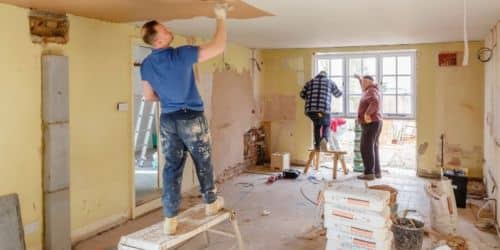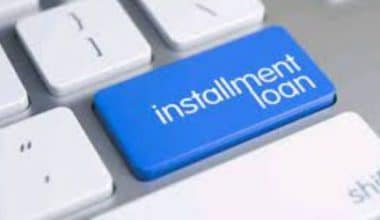Fix and flip loans, also known as “fix n flip loans,” are loans given to a buyer to renovate a distressed home to sell it. In this kind of residential real estate investment, investors purchase a home to sell it as soon as possible for a profit. Fix and flip projects are extremely profitable, but they are expensive because the investor invests a lot of money from the beginning to the end. Fix and flip loans can help offset some of those costs in this situation.
Flipping houses can be profitable if done correctly, but getting started can be difficult financially. Learn more about fix-and-flip loans in the following paragraphs, as well as how to obtain the funding required for your real estate business.
Fix and Flip Loans
A fix-and-flip loan is a brief source of capital that real estate investors use to acquire and improve a home before reselling it for a profit, a process known as house flipping. Fix and flip loans, also referred to as short-term bridge loans, can ease the financial burden of investors’ home improvement costs, which may include everything from minor repairs to total reconstruction.
Lenders take into account the property’s purchase price and after-repair value (ARV) before determining whether and how much money to lend. Usually, loans for fix and flip projects have a fixed interest rate. This kind of loan typically has terms of 6 to 9 months, but in some circumstances, if the rehab’s scope is substantial, terms may go up to 36 months.
Lenders will evaluate your qualifications for a fix-and-flip loan after considering the equity you have in other properties. You are not eligible based on your own financial situation or credit score. The purchase and the rehab, make up the two main components of a fix and flip loan.
#1. The Purchase
The purchasing process is usually simple. The lender receives an application, as well as supporting records and an appraisal. Investors must also provide a Scope of Work (SOW), a business plan for the property that outlines the renovation in detail, along with associated costs. Following loan approval, the investor can complete the purchase and start the rehab phase of the fix and flip.
#2. The Rehab
When the borrower starts the renovation process, they will need to budget the first phase’s expenses, which could include permits and demolition. The borrower may ask for reimbursement after each stage, or “draw,” in financial terms. An inspector makes sure that the renovations are finished after the lender receives payment verification, and then the draw is opened up so that the borrower can proceed to the following stage of construction. After the renovation stage is complete, the borrower has two options: sell the property for a profit or refinance into a longer, 30-year loan with significantly lower rates.
Advantages of Fix and Flip Loans
Fix and flip loans have a lot of benefits that draw in real estate investors. These loans offer quick funding with adaptable terms and interest-only payments, which keeps monthly payments to a minimum. There is no prepayment penalty because these loans typically have short terms. An investor can protect their assets by treating the properties as investments rather than as personal income because they are typically bought through an entity. This implies that, in the worst-case scenario, the property would serve as the lender’s collateral instead of the investor’s personal belongings.
Disadvantages of Fix and Flip Loans
However, fix-and-flip loans have drawbacks and aren’t always the best choice. The short repayment term of this loan results in high-interest rates. The borrower’s financial obligations could increase if the renovations take longer than anticipated or if something prevents the project or sale from moving forward. Lenders frequently prefer to work with experienced flippers who have completed at least two flips. As a result, a first-time borrower might have to pay a higher interest rate. A borrower must also demonstrate that they have the necessary funds in their bank account before they can receive any kind of draw.
Best Fix and Flip Loans
#1. Hard Money Fix and Flip Loans
Hard money fix and flip loans have more stringent requirements than conventional loans, usually with terms of one year or less and high-interest rates based on the after-repaired value (ARV) of the property.
Most times, Hard money lenders frequently charge higher interest rates, even though their repayment terms are frequently shorter than those of other loan types. This could have an impact on how profitable your project is.
A hard money loan is a form of private financing from companies or individuals. Contrary to financing through a bank or other conventional lender, factors like your income and credit score don’t determine eligibility. Lenders request an asset as security for a hard money loan instead. When a borrower’s credit rating, income, or other factors make them ineligible for a traditional loan, hard money loans are a good alternative — and occasionally the only one available.
#2. Home Equity Loans & HELOCs
Investors can use a home equity loan or home equity line of credit (HELOC) to finance your fix and flip project in addition to using your resources, such as your primary residence. Having equity in your home and meeting the other requirements could make you eligible. A home equity loan, also known as a second mortgage, requires you to make a lump sum payment that you can then pay back over a protracted period.
You can make multiple withdrawals from a HELOC up until the start of the repayment period. A home equity loan is a better option if you know exactly how much money you’ll need to buy and fix up your house; however, if you need more funding flexibility, a HELOC is the best option.
Following that, the lender uses a loan-to-value ratio to calculate how much you can borrow. For borrowers to be qualified, having a home with equity and a low debt-to-income ratio are also necessary. Lenders also require a high personal credit score. No prior knowledge of house flipping is necessary to be eligible.
It is easier for borrowers to get the money they need with home equity loans and HELOCs because of their low-interest rates and extended repayment terms. The disadvantage is that it might take some time to approve and give out the loan, making it inappropriate for transactions that need to happen quickly.
#3. Business Lines of Credit
You could use a business line of credit to finance your business operations if you like the idea of a flexible line of credit but would prefer not to risk your home. You will receive authorization for a specific credit limit with a business line of credit. This credit line has a maximum credit limit that you can withdraw from multiple times. You can keep using money from a revolving line of credit as long as you keep making payments on the balance.
The flexibility provided by a business line of credit makes it ideal for fix-and-flip financing. To decide whether you are eligible for a line of credit and to set your credit limit, lenders consider information about your company. Lenders will at the very least consider the length of time you’ve been in operation and your annual revenue. Other lenders might have requirements for yearly income, credit history on both a personal and business level, or both. This isn’t the best option for startups or companies that haven’t yet generated any revenue because you will need to demonstrate some business revenue and at least a few months of operations.
#4. Traditional Mortgage
If you’re more experienced in flipping houses, you may qualify for a traditional loan or mortgage from a bank, credit union, or other financial institution. These operate exactly like your principal mortgage on your home: You receive funding from the lender, spend the money on your purchase, and then spread out the loan repayment over a longer period, usually between 15 and 30 years. The low-interest rates on these loans are a good thing.
It may be challenging to qualify, though. You’ll need to provide proof of prior experience flipping homes, adhere to credit standards, and meet other criteria before a lender will approve you for a mortgage. Some lenders won’t offer mortgages or loans for homes where the owner doesn’t reside. Extremely damaged homes won’t qualify for loans from some lenders.
#5. Bridge Loans
Bridge loans—short-term loans that investors use for fix-and-flip projects—are frequently provided by private lenders, hard money lenders, and other specialty finance firms. Lenders usually require collateral for bridge loans, you may be eligible for a loan with a lower interest rate than you might with some other loan options. Additionally, they are frequently simpler for most borrowers to qualify for than other loans.
If you need to bridge the gap between the time you want to purchase a property and the time you can obtain long-term financing, a bridge loan is a helpful option. When you use a bridge loan to pay for the down payment on your subsequent flip, you can concentrate on looking for another source of funding, like a conventional mortgage, to cover the remaining costs.
#6. Crowdfunding
Working with multiple private lenders instead of just one is a possibility when using a crowdfunding platform to find funding. Another free method of obtaining the funds you require for your fix and the flip project is through crowdfunding websites. These websites collect money from a lot of different people to pay for the investment you have in mind.
Benefits of Fix and Flip Loans
#1. Flexible Terms
Fix and flip loans are excellent for beginning investors due to their flexibility. There are stringent procedures, guidelines, and rules that you must adhere to to obtain a loan from a credit union or bank. Furthermore, the loan approval process frequently takes a long time. Non-bank lenders offer flip loans with more lenient conditions and typically with fewer restrictions.
#2. Fast Approval
Fast approval is available for commercial fix and flip loans. If you want to buy a particular property, you may be able to do so sooner if you apply for one of these loans because the approval process is quick, especially when there is fierce competition for the property. Lenders typically worry about whether the property will be simple to sell after renovation, which means you have the opportunity to benefit from current real estate prices in your local market. When you provide these platforms with a clear picture of your repayment strategy, lenders make the process easier. These loans are quick to approve, and they close more quickly than other options.
#3. Regulating the Buyer’s Mortgage Rate
You can build, fix, and buy the property with the help of Flip funding services. This funding choice has a lower interest rate when compared to traditional lending options. As a result, it is possible to provide the buyer with a better price, which ultimately helps the property sell more quickly.
#4. Types of Properties
Various properties, whether residential or commercial, may be eligible for a fix-and-flip real estate project. The kind or state of the property you want to purchase does not affect your chances of getting loan approval. There are stringent requirements for funding the property if you applied for a loan from the bank. Consider fix-and-flip loans if you intend to renovate a potential rental property.
Fix and Flip Loans for Beginners
Fix and flip investments should be taken into account by newcomers to the real estate investing industry as well as seasoned investors looking for fresh opportunities. Hard money lenders for flipping houses can be used to finance a variety of projects, but doing so requires using reputable online forums to connect with lenders.
Before selecting a home to flip, you must be truthful about the condition of the property and the amount of work required. While having a clear vision of the finished product is important, it’s equally important, to be honest about the time and resources required to get there. When you are prepared to start a project after extensive research, bear in mind the following principles:
It’s crucial to find the best fix-and-flip hard money lenders or source from a flexible platform because the cost of flipping houses can change.
Before starting, learn as much as you can about the neighborhood market.
Get in touch with other flippers, particularly the more experienced ones. These knowledgeable flippers can help you with their expertise and experience.
Commercial Fix and Flip Loans
Typically, a speculator will buy a foreclosed commercial property using a commercial fix and flip loan. Currently, the loans for commercial fixes and flips are being closed by private money lenders, also known as hard money lenders. The hardest money lenders are willing to lend you 60% or less of the REO’s purchase price. The property will then be your responsibility to repair and sell (flip). As a result, before you can lease the property, you might need to put down 40% of the purchase price, make all necessary repairs, and pay the loan in full.
The Best Ways to Repair and Resell Commercial Real Estate
#1. Property Evaluation
Finding a good house to flip is the first step. When evaluating a commercial property, factors like location, market demand, and the potential for remodeling should be taken into consideration. You might want to concentrate on houses that just need some cosmetic work done, as these are usually less expensive to renovate than ones that need major structural changes. Above all, exercise caution when deciding to invest in an asset class with which you are unfamiliar.
#2. Plan Your Renovations Thoroughly
You need to have a good plan in place before you start the renovation process. Commercial property can gain value through a well-executed renovation, but it can lose value significantly through a poorly executed one. An extensive inspection of the property is recommended before beginning any work to find any problems that must be fixed. The flaws in a property don’t all have to be fixed in a fix-and-flip investment. Be practical about the issues you must tackle, though: To avoid being caught off guard by taking on more than you can handle, be sure to carefully examine any potentially significant issues.
#3. Secure the Best Financing
The success of your investment strategy may depend on whether you can secure the ideal fix-and-flip loan, as was previously mentioned. Make sure you are looking at the appropriate loan type, which is described at the top of this page, and that you can obtain the financing you require for your project’s expenses.
#4. Select Experienced Contractors
For the renovation to be completed correctly, it’s also critical to collaborate with a group of skilled designers and contractors. You have an advantage if you have previously worked with a team that you trusted.
As you work quickly without sacrificing quality, keep in mind that time is money in the fix-and-flip business.
#5. Advertise Your Property
The last step is to get ready to sell your house, probably even before all the work is finished. This could entail using online listing services or collaborating with a commercial real estate agent to spread the word. Make every effort to increase interest if you want to sell your renovated property for the highest price. Before putting your property on the market, know what the ideal sale price is. Even though it was easy to be steadfast when the project was being planned, the market may have changed since then — either for the better or for the worse. The price at which your property will sell depends heavily on your understanding of the local market.
How Do Fix and Flip Loans Work?
Any loan product used to pay for the purchase and renovation of a real estate property is referred to as a fix-and-flip loan. Hard money loans, home equity loans, HELOCs, business lines of credit, ROBS financing, conventional mortgages, and personal loans are some possible forms of these loans.
Do Banks Give Fix and Flip Loans?
Banks don’t frequently offer loan programs designed for fix and flip financing. Private lenders may be the most advantageous source of fix and flip loans for novices.
What Credit Score Do You Need for Fix and Flip Loan?
Qualifying for a fix and flip loan is a little bit simpler because hard money brokers, make them so rather than commercial banks. Generally speaking, you require a credit score of at least 620, though this figure is NOT inflexible. For best results, your FICO score should be at least 620 to be eligible for a fix-and-flip loan.
Is Fund That Flip a Hard Money Lender?
When you work with Fund That Flip, you can expect the fastest closing time in the business, dependable funding, and a committed team to help you grow your company. One of the simplest ways to expand your real estate company is through hard money loans. Accredited investors can add real estate to their portfolios with little risk by using the Fund That Flip platform, which eliminates the need for a traditional loan to purchase an investment property. The platform serves both borrowers and lenders who are looking for their next real estate financial solution.
How Can I Flip My House With No Money and Bad Credit?
If you don’t have any money in the bank and want to do a house flip, you’ll need to get some financing. Hard money loans, home equity loans, HELOCs, business lines of credit, financing for rollover as business startup (ROBS), personal loans, and traditional mortgages are among the different loan types that are available for flipping houses.
Lenders will typically consider your loan-to-value ratio (LTV) and after-repair value (ARV) when evaluating your application for a fix and flip loan. The loan’s size about the property’s value is known as the LTV. 90% is the average LTVS cap for lenders, though some may have higher or lower standards.
According to the ARV of the property, other lenders determine how much you can borrow. After renovations, the property’s estimated value is as follows. You might need to put down money when applying for a lot of loans. But some hard money and private lenders might be able to finance your real estate deal entirely and without any down payment.
You might also take into account other, more sophisticated techniques for flipping homes, like wholesaling, which entails contracting for a property and then selling that contract to another buyer. Before diving into these various loans and strategies, think about speaking with a seasoned real estate investor and carefully weighing your options.
How Do You Get Money for a Fix and Flip?
- Traditional Lending.
- Non-bank lenders or Private Lenders
- Crowdfunding sites
- Hard money lender
Is Fix and Flip Risky?
Investing in a fix and flip is riskier if you don’t have the cash to purchase the home. Many investors who flip houses use loans, and you might discover that a mortgage is the best choice for you as well. To maximize the benefits of a mortgage, research is necessary. Look into your options for a mortgage and contrast them with other offers. Your investment property’s sale at a profit or even its sale altogether is neither promise nor assurance.
What Is the 70% Rule in House Flipping?
According to this general rule, a buyer who intends to sell the property shouldn’t shell out more than 70% of the after-repair value (ARV), which includes the cost of renovation. Approximately 30% of the equity is thus left available for profit when the property is sold, acting as a safety net if costs turn out to be higher than anticipated.
The after-repair value (ARV) of a property should not exceed 70% of its ARV, less the cost of renovation, according to the “70% rule,” a general principle (rather than a formal rule or requirement). Home flippers can use this quick and simple method to determine the highest price they should offer for a property.
Conclusion
A short-term loan known as a “fix and flip loan” is given to real estate investors who use the money to buy and/or renovate properties before reselling them for a profit. It is utilized for professional, not private, reasons. Fix and flip loans are an essential tool for gaining access to the houses you want to renovate before selling for a profit. Online Platforms or lenders are a great place to start if you’re searching for hard money loans for flipping houses because they are willing to lend to beginners.
Related Articles
- BEST HOME IMPROVEMENT LOAN IN 2023
- How To Flip a House In 2023| Beginners Step by Step Guide
- How to Get a Real Estate License in California: Requirements, Steps & Guide
- Open House Ideas: 15+ Ideas That Generate Effective Real Estate Leads
- TOP BEST 2023 VACATION RENTAL SOFTWARE: Reviews & Pricing






